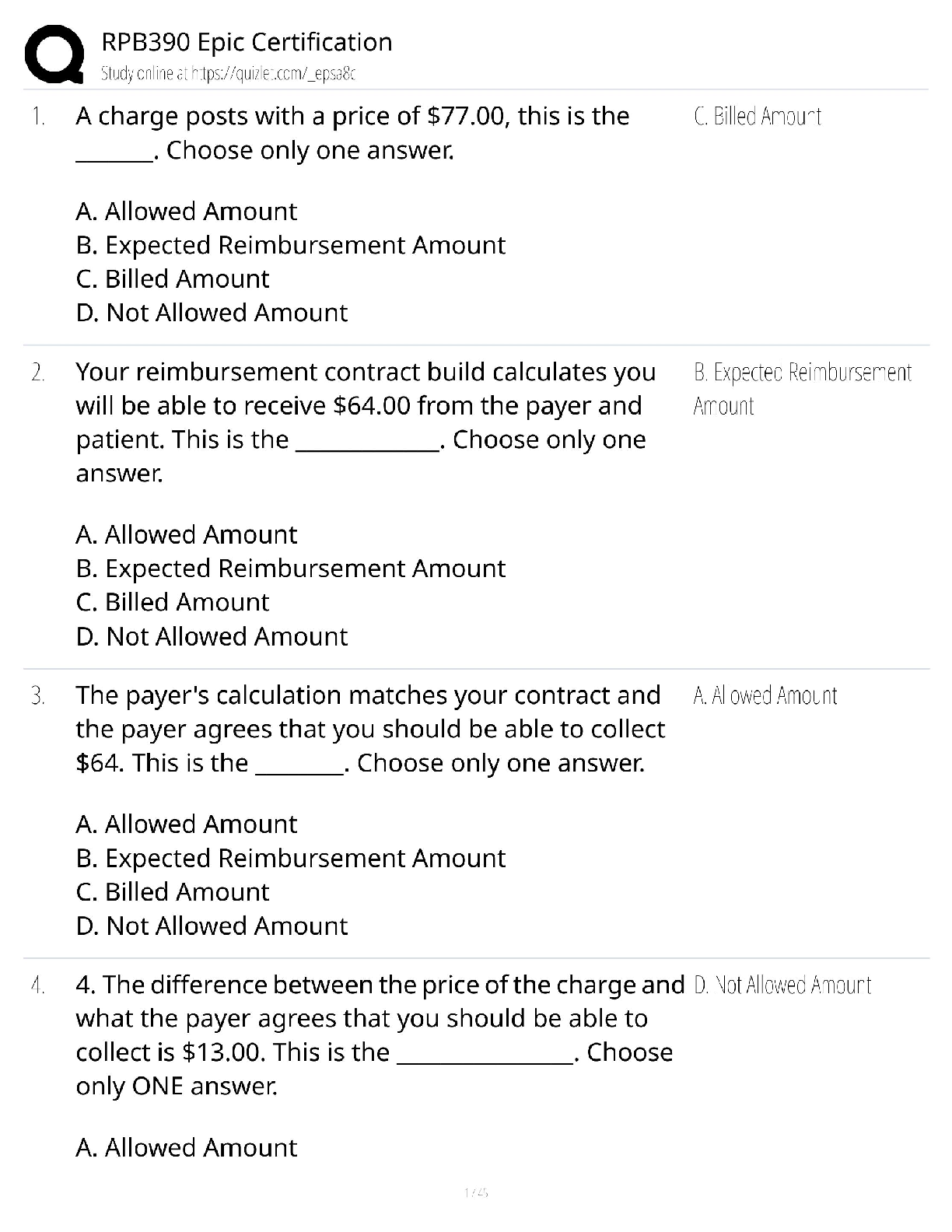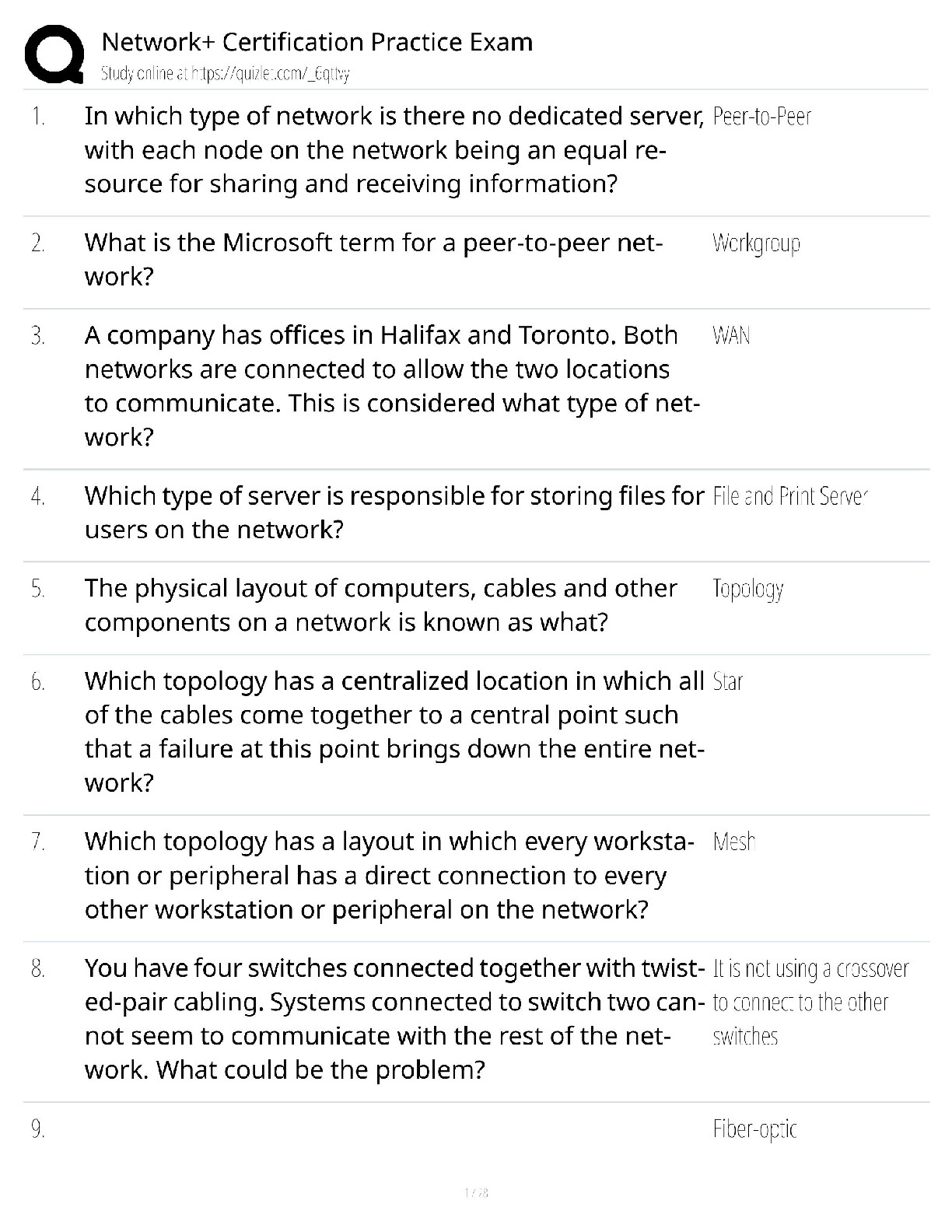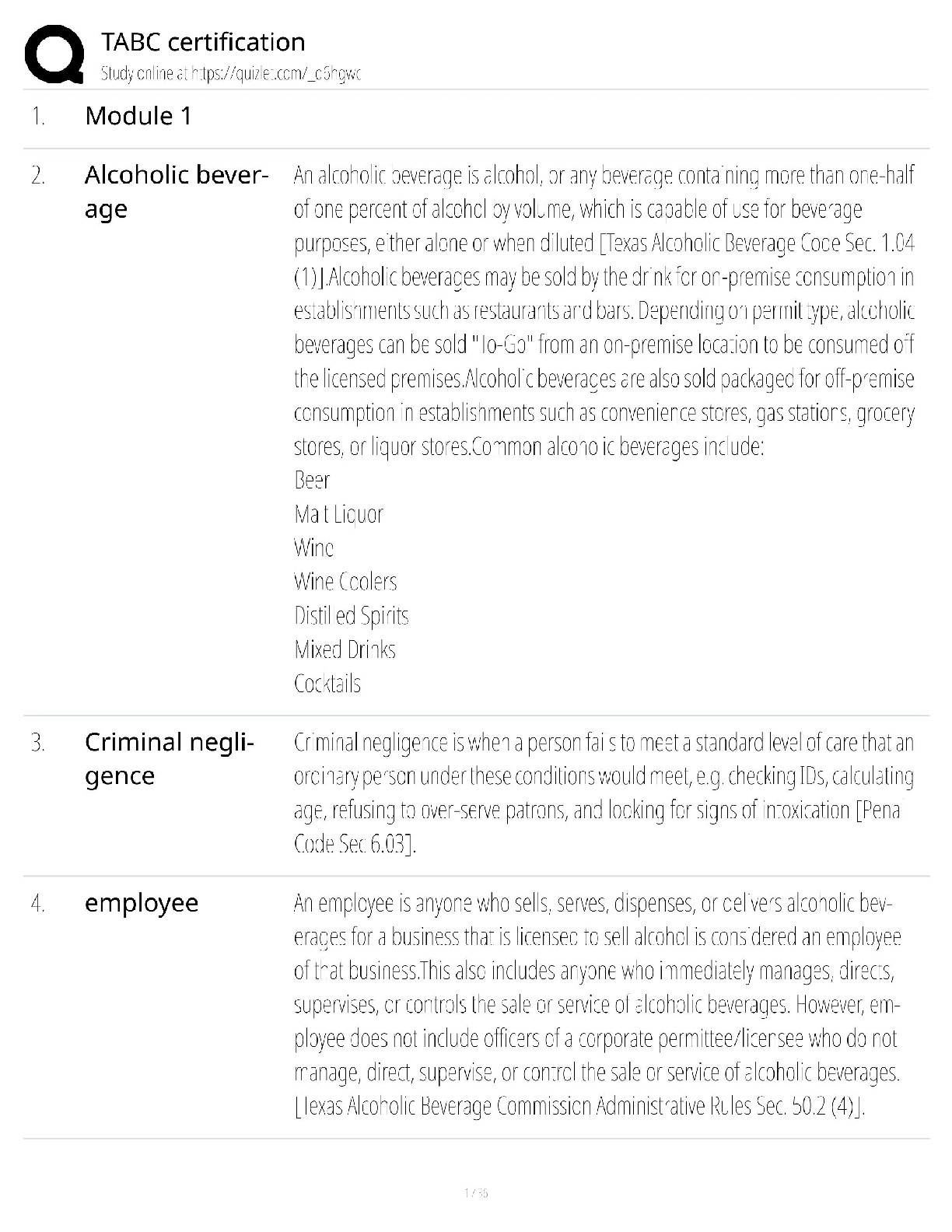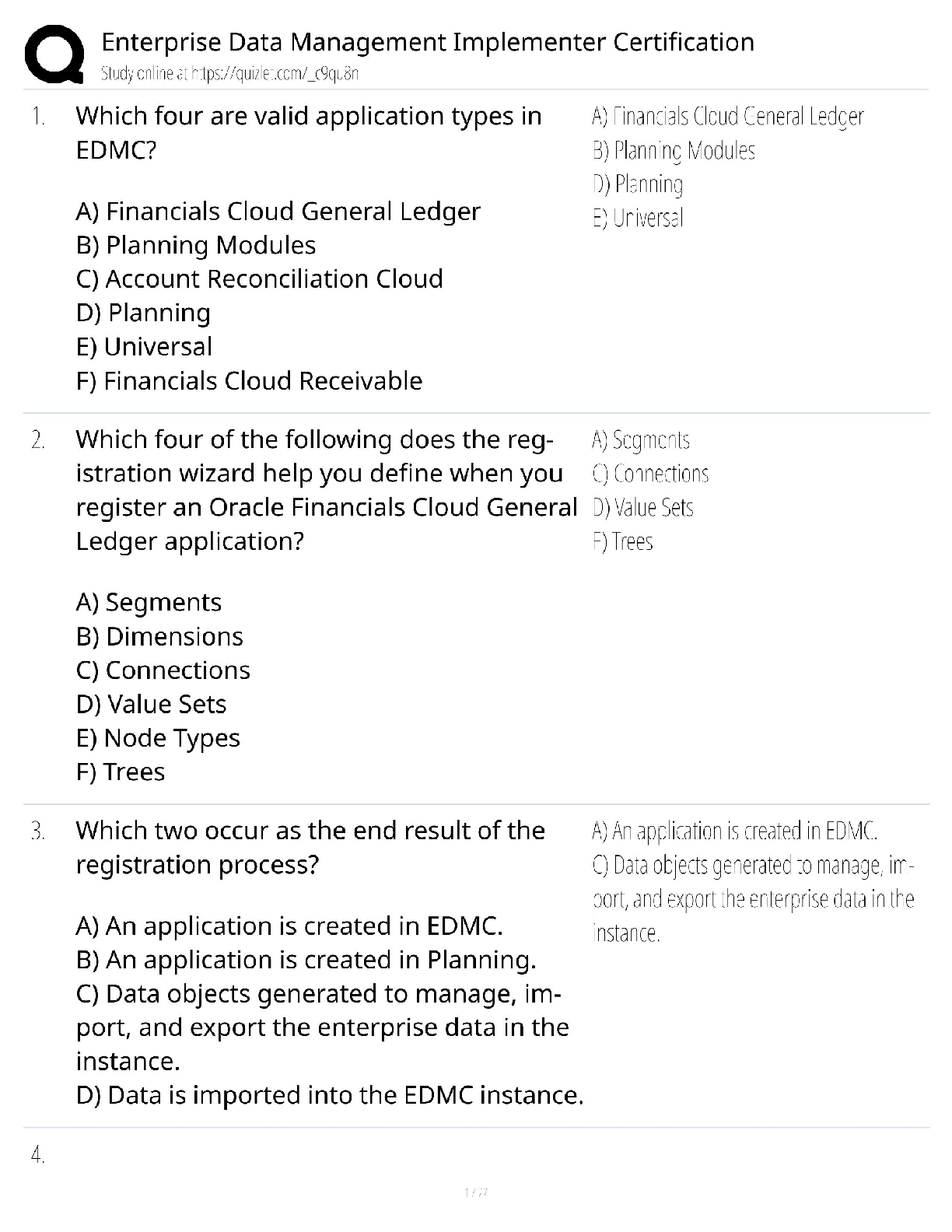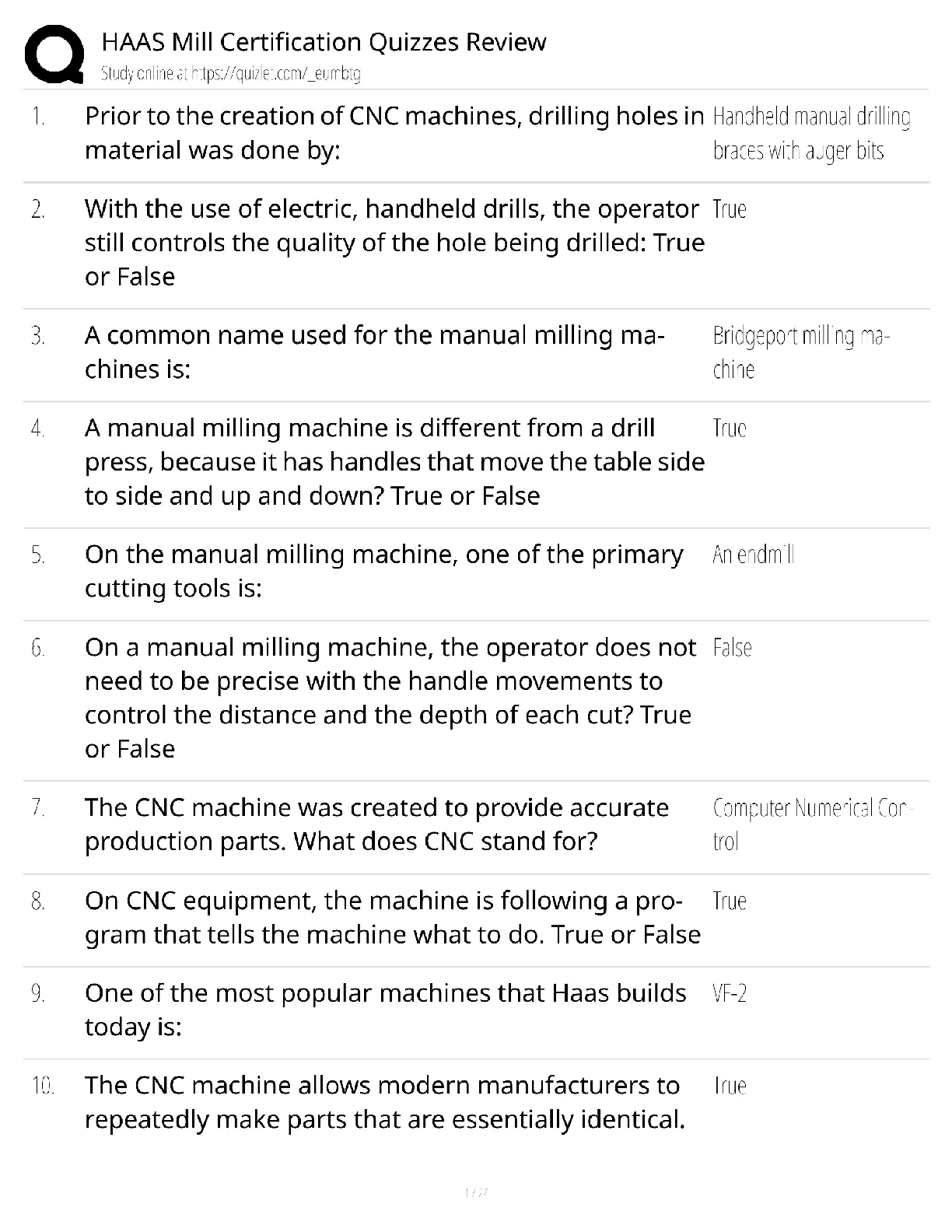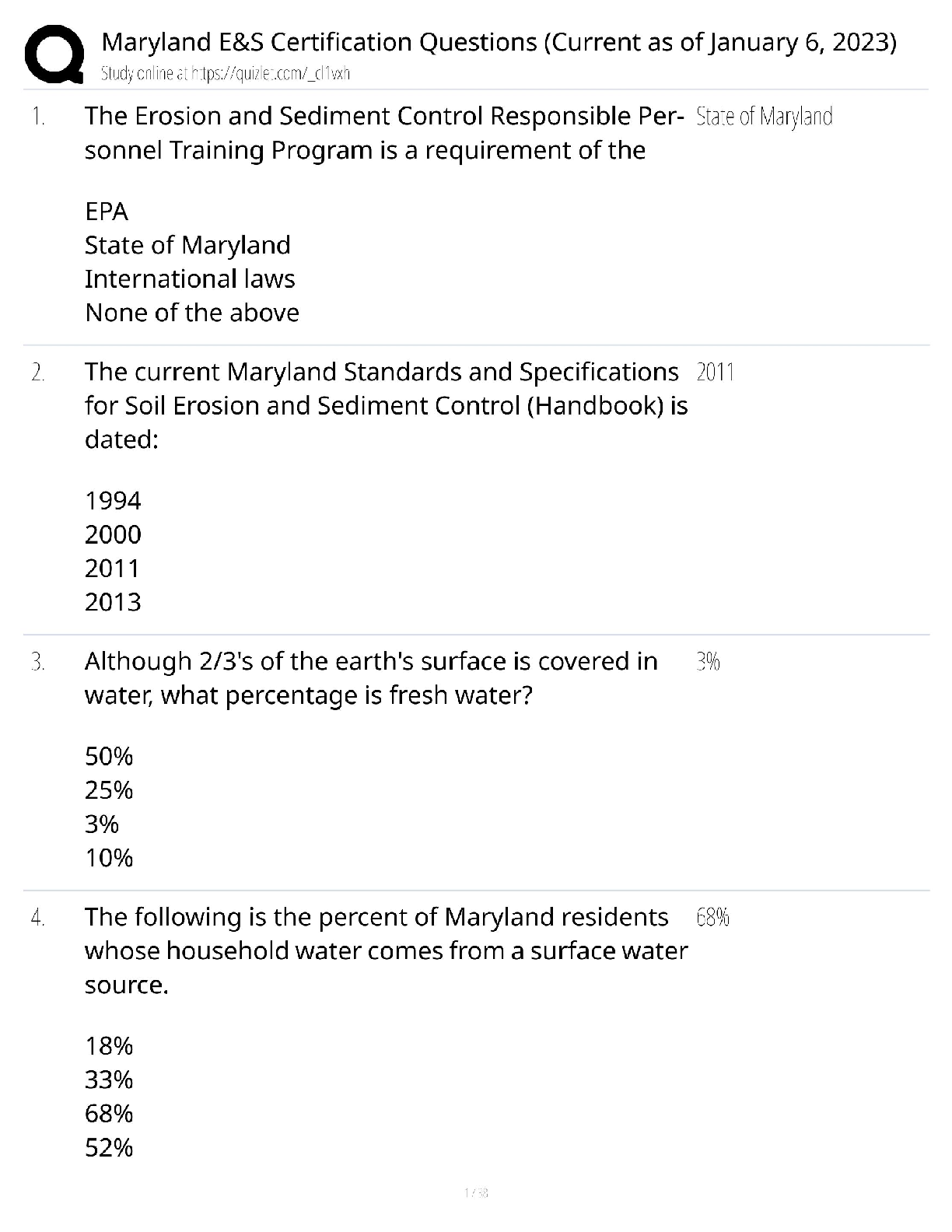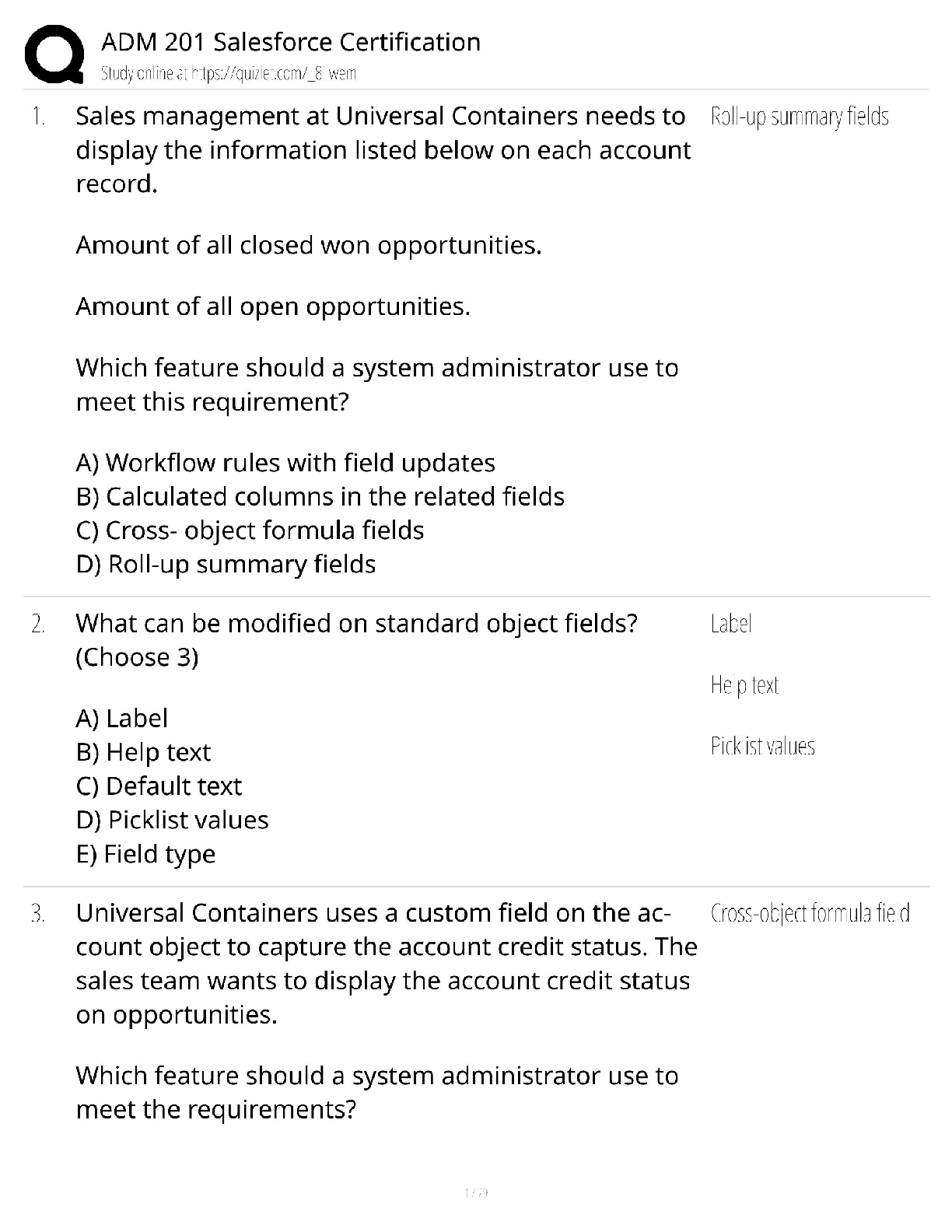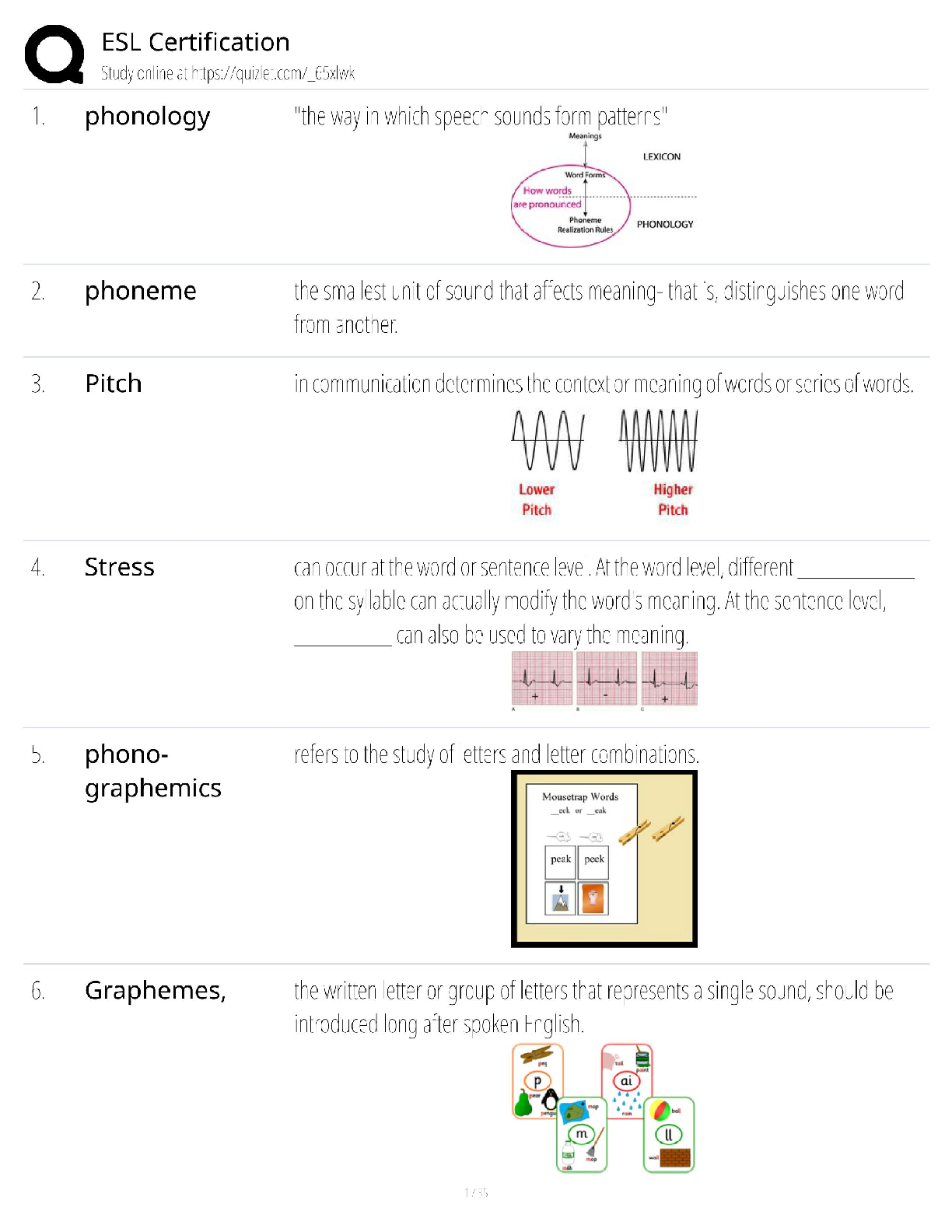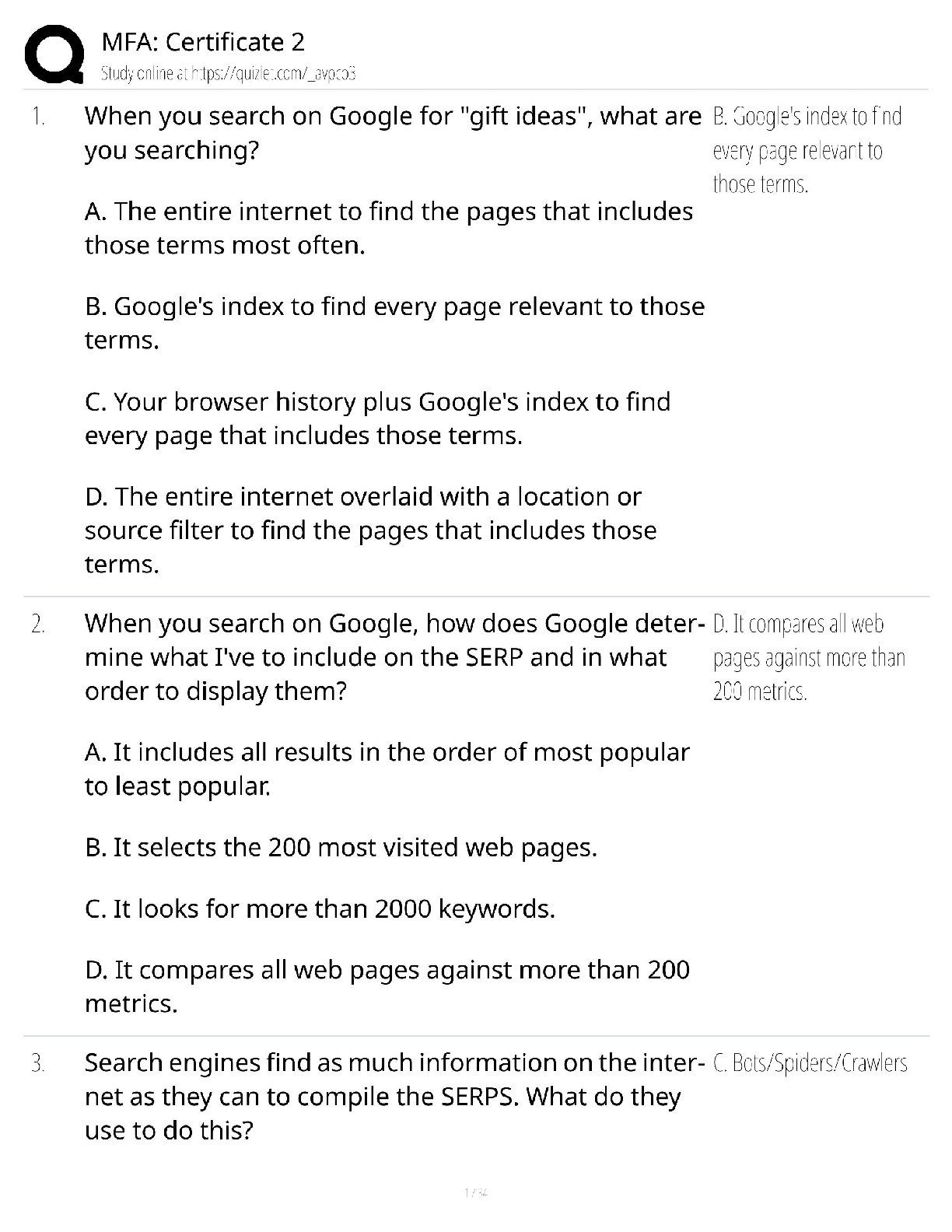Mathematics > QUESTIONS & ANSWERS > MATH 225N Unit 7 Examples (Test_Quiz)_Fall 2021_Already Graded A. (All)
MATH 225N Unit 7 Examples (Test_Quiz)_Fall 2021_Already Graded A.
Document Content and Description Below
Unit 7.1 Which graph below corresponds to the following hypothesis test? H0:μ≥5.9, Ha:μ<5.9 The alternative hypothesis, Ha, tells us which area of the graph we are interested in. Because the al ... ternative hypothesis is μ<5.9, we are interested in the region less than (to the left of) 5.9, so the correct graph is the first answer choice. Question: Jolyn, a golfer, claims that her drive distance is not equal to 222 meters, on average. Several of her friends do not believe her, so she decides to do a hypothesis test, at a 5% significance level, to persuade them. She hits 11 drives. The mean distance of the sample drives is 218 meters. Jolyn knows from experience that the standard deviation for her drive distance is 14 meters. H0: μ=222; Ha: μ≠222 α=0.05 (significance level) What is the test statistic (z-score) of this one-mean hypothesis test, rounded to two decimal places? Answers: Test statistic = −0.95 The hypotheses were chosen, and the significance level was decided on, so the next step in hypothesis testing is to compute the test statistic. In this scenario, the sample mean distance, x¯=218. The sample the golfer uses is 11 drives, so n=11. She knows the standard deviation of the drives, σ=14. Lastly, the golfer is comparing the population mean distance to 222meters. So, this value (found in the null and alternative hypotheses) is μ0. Now we will substitute the values into the formula to compute the test statistic:Question: What is α, the probability of a Type I error if the null hypothesis, H0, is: Carmin believes that her chemistry exam will only cover material from chapters four and five. Answer: the probability that Carmin believes that her chemistry exam will not cover material only from chapters four and five when, in fact, it will only cover material from chapters four and five A Type I error is the decision to reject the null hypothesis when it is true. In this case, the Type I error is when Carmin believes that her chemistry exam will not cover only material from chapters four and five when, in reality, it will. Question Suppose the null hypothesis, H0, is: Darrell has enough money in his bank account to purchase a new television. What is the Type II error in this scenario? Answer: Darrell thinks he has enough money in his bank account to purchase the television when, in fact, he does not. A Type II error is the decision not to reject the null hypothesis when, in fact, it is false. In this case, the Type II error is when Darrell thinks he has enough money in his account to purchase the television when, in fact, he does not. Question: A pharmaceutical company claims that at least 38% of adults between the ages of 30 and 40 are overweight. A research group does not think this is accurate and wants to show that less than 38% of these adults are overweight. Identify the group's null hypothesis, H0, and the alternative hypothesis, Ha, in terms of the parameter p. Answer: H0: p≥0.38; Ha: p<0.38 Let the parameter p be used to represent the proportion. The null hypothesis is always stated with some form of equality: equal (=), greater than or equal to (≥), or less than or equal to (≤). Therefore, in this case, the null hypothesis H0 is p≥0.38. The alternative hypothesis is contradictory to the null hypothesis, so Ha is p<0.38. Also, remember that the alternative hypothesis is always the statement that the researcher or study is trying to show. In this case, the group is trying to show that the pharmaceutical company is wrong. In other words, they are trying to show that p<0.38, so that is the alternative hypothesis, Ha. The null hypothesis, H0, is the opposite of this, p≥0.38.Unit 7.2 For a right-tailed test, if the test statistic (z0) is more than the critical value (zα), we should reject the null hypothesis. For a left-tailed test, if the test statistic (z0) is less than the critical value (zα), we should reject the null hypothesis Reject = “data provide sufficient evidence to conclude that the….” Do Not Reject = “The test results are not statistically significant” Question Hugo, a pitcher, claims that his pitch speed is more than 48 miles per hour, on average. Several of his teammates do not believe him, so he decides to do a hypothesis test, at a 5% significance level, to persuade them. He throws 15 pitches, collects the proper data, and works through the testing procedure: H0: μ≤48; Ha: μ>48 α=0.05 (significance level) The test statistic is The critical value is z0.05=1.64. Conclude whether to reject or not reject H0,and interpret the results. Answer: Reject H0. At the 5% significance level, the data provide sufficient evidence to conclude that the mean speed is more than 48 miles per hour. Conclusion: This is a right-tailed test, because Ha would be if the average pitch speed is more than 48 miles per hour. For a right-tailed test, if the test statistic (z0) is more than the critical value (zα), we should reject the null hypothesis. We know that z0=4.65 and zα=1.64. Because z0>zα, we reject the null hypothesis, which stated that the average pitch speed is less than or equal to 48 miles per hour. Question: The test statistic for the HR manager's hypothesis test about the mean percentage of agenda-less meetings is −0.26. The critical value is −1.960. The rejection region is left-tailed. Conclude whether to reject or not reject H0, and interpret the results. Answer: Do not reject H0. The test results are not statistically significant and at best, provide weak evidence against the null hypothesis. In a left-tailed test, if the test statistic is less than the critical value, it is in the rejection region. However, for this study, it is greater than, so we do not reject the null hypothesis. −0.26>−1.960Question Determine the critical value or values for a one-mean z-test at the 2% significance level if the hypothesis test is left-tailed (Ha:μ<μ0). Answer: −2.054 For a left-tailed hypothesis test, the rejection region is on the left. Because the test is left-tailed, the critical value is negative. We know that α=0.02, so the area to right of the z-score is equal to 0.02, and we will use z0.02=−2.054 as our critical value. Unit 7.3 If α>p-value, reject H0 because the results of the sample data are significant If a<p-value, do NOT reject the null hypothesis. Question: Mary, a javelin thrower, claims that her average throw is 61 meters. During a practice session, Mary has a sample throw mean of 55.5 meters based on 12 throws. At the 1% significance level, does the data provide sufficient evidence to conclude that Mary's mean throw is less than 61 meters? Accept or reject the hypothesis given the sample data below. H0:μ=61 meters; Ha:μ<61 meters α=0.01 (significance level) z0=−1.99 p=0.0233 Answer: Do not reject the null hypothesis because the p-value 0.0233 is greater than the significance level α=0.01. In making the decision to reject or not reject H0, if α>p-value, reject H0 because the results of the sample data are significant. There is sufficient evidence to conclude that H0 is an incorrect belief and that the alternative hypothesis, Ha, may be correct. If α≤p-value, do not reject H0. The results of the sample data are not significant, so there is not sufficient evidence to conclude that the alternative hypothesis, Ha, may be correct. In this case, α=0.01 is less than or equal to p=0.0233, so the decision is to not reject the null hypothesis. Question: Marty, a typist, claims that his average typing speed is 72 words per minute. During a practice session, Marty has a sample typing speed mean of 84 words per minute based on 12 trials. At the 5% significance level, does the data provide sufficient evidence to conclude that his mean typing speed is greater than 72 words per minute? Accept or reject the hypothesis given the sample data below. H0:μ≤72 words per minute; Ha:μ>72 words per minute α=0.05 (significance level) z0=2.1 p=0.018 Answer: Reject the null hypothesis because the p-value 0.018 is less than the significance level α=0.05. In making the decision to reject or not reject H0, if α>p-value, reject H0 because the results of the sample data are significant. There is sufficient evidence to conclude that H0 is an incorrect belief and that the alternative hypothesis, Ha, may be correct. If α≤p-value, do not reject H0. The results of the sample data are not significant, so there is not sufficient evidence to conclude that the alternative hypothesis, Ha, may be correct. In this case, p=0.018 is less than the significance level α=0.05, so the decision is to reject the null hypothesis.Question: What is the p-value of a left-tailed one-mean hypothesis test, with a test statistic of z0=−0.88? (Do not round your answer; compute [Show More]
Last updated: 3 years ago
Preview 1 out of 13 pages

Buy this document to get the full access instantly
Instant Download Access after purchase
Buy NowInstant download
We Accept:

Also available in bundle (1)
Click Below to Access Bundle(s)

MATH 225N Week 1, week 2, week 3, week 4, week 5, week 6, week 8 Assignments & Quizes| Latest Edition 2021
MATH 225N Week 1, week 2, week 3, week 4, week 5, week 6, week 8 Assignments & Quizes| Latest Edition 2021
By d.occ 4 years ago
$45
18
Reviews( 0 )
$11.00
Can't find what you want? Try our AI powered Search
Document information
Connected school, study & course
About the document
Uploaded On
Jul 29, 2021
Number of pages
13
Written in
All
Additional information
This document has been written for:
Uploaded
Jul 29, 2021
Downloads
0
Views
155








.png)

.png)



